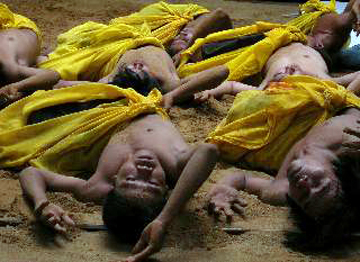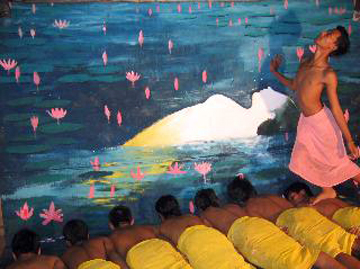After the Killing Fields
Cambodian Stories: An Offering in Painting and Dance
Eiko & Koma with The Reyum Painting Collective
Robert and Arlene Kogod Theatre, Clarice Smith Performing Arts Center
College Park, MD
Thursday, March 30, 2006
by Lisa Traiger
copyright 2006, Lisa Traiger
 More than a quarter century ago, 1.7 million Cambodians lost their lives, were starved, tortured or worked to death by the Khmer Rouge under orders from Pol Pot and his Communist party henchman. What the killing fields and mass genocide wrought for the generation to follow is the unspoken yet ever-present subject of "Cambodian Stories: An Offering in Painting and Dance," a world premiere by Eiko & Koma, who for the first time are joined by a group of dancing collaborators. The teenage art students from Phnom Penh's Reyum Painting Collective contribute to this rare and wondrous onstage collaboration, adding dimension both with their live-action painting and their movement delicately shot through with heart and soul.
More than a quarter century ago, 1.7 million Cambodians lost their lives, were starved, tortured or worked to death by the Khmer Rouge under orders from Pol Pot and his Communist party henchman. What the killing fields and mass genocide wrought for the generation to follow is the unspoken yet ever-present subject of "Cambodian Stories: An Offering in Painting and Dance," a world premiere by Eiko & Koma, who for the first time are joined by a group of dancing collaborators. The teenage art students from Phnom Penh's Reyum Painting Collective contribute to this rare and wondrous onstage collaboration, adding dimension both with their live-action painting and their movement delicately shot through with heart and soul.
"Cambodian Stories" works sparely, quietly, ruminatively on watchers, so much so that at the end of 80 minutes it nearly comes as a surprise how far on this journey through pain and toward healing we have traveled with these ten precious youths and Eiko and Koma. In the black box of the Kay Theater the sun and sand of Cambodia are suggested by David Ferri's hot yellow-white lighting and the sand and earth covered stage floor. Reyum's art students—who attend the school for half days because their academic programs can't accommodate full-day schooling—created all the painted backdrops and hanging detachable wings, which feature a rendering of a reserved Cambodian woman, the many faces of an earth mother. The students collaboratively paint two additional works in the course of the performance.
Most intriguing about this collaboration is how closely aligned their distinctive approaches seem. There's naivety and evocative grace in the naturally based movements on which Eiko and Koma have focused on for 30 years. They telescope time and space traversing ever slowly minute distances in a mannered approach that seems as if they're crossing continents. They have taught a generation of open-minded dance goers how to look and how to see, by revealing the minute changes in position and the infinitesimally slow—a shift of a shoulder, a cock of a pinky finger, a near-imperceptible rise and fall of the belly breathing deep and low. These Eiko and Koma trademarks, along with their white painted skin, evoke the elemental, the primordial, prehistorical and post-apocalypse. There's simplicity in the evenness and sustainment that lends itself to thinking about the complexities of who those primitive creatures could be.
 The painting students—artists in their own right—approach their work with a similar simplicity and naivity that returns to the viewer complex ideas and emotions. They can skillfully and quickly paint folk-art human figures that on the surface seem what they are yet beneath evoke depths of emotional baggage—and that they paint women, this mostly male group demonstrates a respect and veneration for motherhood and femininity. That Eiko and Koma found and aligned themselves with these like-minded painters seems at once miraculous and entirely preordained.
The painting students—artists in their own right—approach their work with a similar simplicity and naivity that returns to the viewer complex ideas and emotions. They can skillfully and quickly paint folk-art human figures that on the surface seem what they are yet beneath evoke depths of emotional baggage—and that they paint women, this mostly male group demonstrates a respect and veneration for motherhood and femininity. That Eiko and Koma found and aligned themselves with these like-minded painters seems at once miraculous and entirely preordained.
By introducing the painting students to movement in their delicious anti-egoistic way, purely, naturally, at the core primitively, Eiko and Koma unveil further depth of meaning. This skin painted white, now middle aged, the pair suggest ancestors, ancient, ghostly, of these youngsters. Grandfather and grandmother or apparition, their presence serves to recollect for these youths to their lost past. Their charges are smooth skinned, brown, vibrant, full of life - and hope.
Painting is as central to the performance as movement, and following bows and introductions in broken English by the shy young men, the evening begins as the group carries out a wooden scaffold-like system, which they lay atop an oversized floor canvas. Within moments and in complete unison, they have painted a larger-than-life Cambodian woman, almond eyed, sarong wrap, she's still, static, yet the movement involved as these boy-men scrambled over the scaffold, dipping their brushes and fingers in paint, sweeping and blotting, transforming a white nothingness with color becomes itself a fascinating dance. Jackson Pollack and his ilk once called their abstracted drips and splatters action painting. These Reyum artists redefine action art in their collaborative and wholly physical and dancerly means of painting.
Music director Sam-Ang Sam selected both traditional Cambodian works and more contemporary pop-flavored ballads that these youths were raised hearing. The most moving is the Dylanesque tune "Take Me to Your Heart," sung with an English refrain by Preap Sovat, to which a chain of dancers linked by clasped hands carves a path on stage, while singing along.
 Chakreya So, the only woman in the group, is frequently the lead or central performer and her mystical, closed-eye sideways walk, her arms outstretched in an intense reach, seems at first naively rendered, but as the evening builds, one begins to know the unaffected and deep-seated purposeful intent she has. Later she becomes the sacrifice, death laid gently on a pile of sand, cradled lovingly. Both mother figure and daughter, the painters replicate her on a theater-sized canvas as a mythical creature arising from the water awash in moonlight, her hair flowing, her face placid, borne in a rising arc for a purpose. She's both death and rebirth, natural, pure, clad in a white traditional woman's skirt and fitted top, a charabab. So's partner and the lead male, Setpheap Sorn, is Eiko and Koma's most beautiful find and his name means 'peace'. He carries himself with an unselfconscious and preternatural grace that cries for further dance training. He seems to have the body and soul of a dancer buried within.
Chakreya So, the only woman in the group, is frequently the lead or central performer and her mystical, closed-eye sideways walk, her arms outstretched in an intense reach, seems at first naively rendered, but as the evening builds, one begins to know the unaffected and deep-seated purposeful intent she has. Later she becomes the sacrifice, death laid gently on a pile of sand, cradled lovingly. Both mother figure and daughter, the painters replicate her on a theater-sized canvas as a mythical creature arising from the water awash in moonlight, her hair flowing, her face placid, borne in a rising arc for a purpose. She's both death and rebirth, natural, pure, clad in a white traditional woman's skirt and fitted top, a charabab. So's partner and the lead male, Setpheap Sorn, is Eiko and Koma's most beautiful find and his name means 'peace'. He carries himself with an unselfconscious and preternatural grace that cries for further dance training. He seems to have the body and soul of a dancer buried within.
"Cambodian Stories" is filled with moments of serendipity—little places of found wonder as these boy-men unselfconsciously find their voices through bodily expression. And while the work, for Americans of the generations that remember the war and genocide, carries the weight of 1.7 million who perished, it also reflects that rebirth comes with a new unsullied generation and when it does it springs forth with grace and creativity, heart and soul. That is the true offering Eiko and Koma have given us.
Volume 4, No. 13
April 3, 2006
copyright ©2006 Lisa Traiger
www.danceviewtimes.com